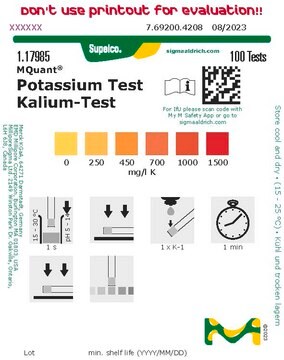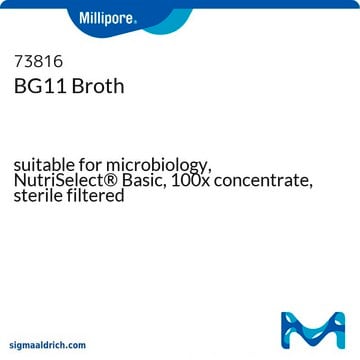If this product has an expiration or retest date, it will be shown on the Certificate of Analysis (COA, CofA). If there is no retest or expiration date listed on the product's COA, we do not have suitable stability data to determine a shelf life. For these products, the only date on the COA will be the release date; a retest, expiration, or use-by-date will not be displayed.
For all products, we recommend handling per defined conditions as printed in our product literature and website product descriptions. We recommend that products should be routinely inspected by customers to ensure they perform as expected.
For products without retest or expiration dates, our standard warranty of 1 year from the date of shipment is applicable.
For more information, please refer to the Product Dating Information document: https://www.sigmaaldrich.com/deepweb/assets/sigmaaldrich/marketing/global/documents/449/386/product-dating-information-mk.pdf
MAK022
Calcium Colorimetric Assay
sufficient for 250 colorimetric tests
About This Item
Recommended Products
usage
sufficient for 250 colorimetric tests
application(s)
cosmetics
food and beverages
detection method
colorimetric
relevant disease(s)
neurological disorders; hematological disorder
storage temp.
2-8°C
General description
Application
Features and Benefits
Suitability
Principle
replaced by
Signal Word
Danger
Hazard Statements
Precautionary Statements
Hazard Classifications
Aquatic Chronic 3 - Eye Dam. 1 - Skin Irrit. 2
Storage Class Code
12 - Non Combustible Liquids
Flash Point(F)
Not applicable
Flash Point(C)
Not applicable
Choose from one of the most recent versions:
Certificates of Analysis (COA)
Don't see the Right Version?
If you require a particular version, you can look up a specific certificate by the Lot or Batch number.
Already Own This Product?
Find documentation for the products that you have recently purchased in the Document Library.
Customers Also Viewed
-
How can I determine the shelf life / expiration / retest date of this product?
1 answer-
Helpful?
-
-
How is shipping temperature determined? And how is it related to the product storage temperature?
1 answer-
Products may be shipped at a different temperature than the recommended long-term storage temperature. If the product quality is sensitive to short-term exposure to conditions other than the recommended long-term storage, it will be shipped on wet or dry-ice. If the product quality is NOT affected by short-term exposure to conditions other than the recommended long-term storage, it will be shipped at ambient temperature. As shipping routes are configured for minimum transit times, shipping at ambient temperature helps control shipping costs for our customers. For more information, please refer to the Storage and Transport Conditions document: https://www.sigmaaldrich.com/deepweb/assets/sigmaaldrich/marketing/global/documents/316/622/storage-transport-conditions-mk.pdf
Helpful?
-
-
Could you provide the Kd (binding affinity) for calcium and clarify if the kit measures all calcium or just free/unbound calcium?
1 answer-
The kit uses the chromogenic complex (λ = 575 nm) formed between calcium ions and 0-cresolphthalein, specifically measuring free calcium and not the bound calcium. However, there is no available information regarding the Kd (binding affinity).
Helpful?
-
-
For the analysis of the standard curve, is it supposed to result in a linear curve or plotted as a polynomial?
1 answer-
The standard curve for product MAK022 should be fitted using linear regression. The x-axis will be the 0 (assay blank), 0.4, 0.8, 1.2, 1.6, and 2.0 μg/well standards with the OD 575 nm on the y-axis for each of the respective standards after the standard blank subtraction.
Helpful?
-
-
Hello, just wanted to confirm if this assay detects the free Ca2+ only and not the bound Calcium, correct?
1 answer-
Yes, this kit measures only free calcium and not bound calcium. The kit utilizes the chromogenic complex formed between calcium ions and 0-cresolphthalein.
Helpful?
-
Active Filters
Our team of scientists has experience in all areas of research including Life Science, Material Science, Chemical Synthesis, Chromatography, Analytical and many others.
Contact Technical Service







